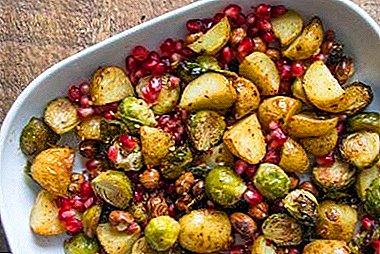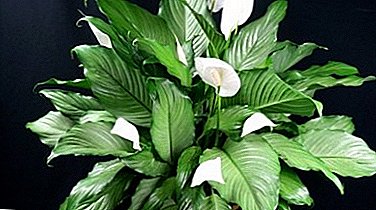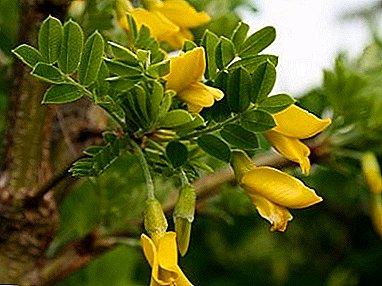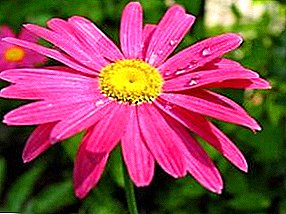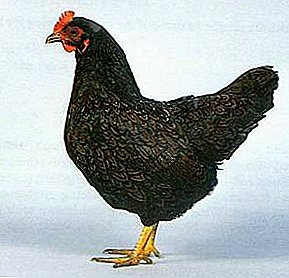
Garlic can be grown in two ways: spring and winter. Spring garlic contains more nutrients, although the cloves are smaller.
Experienced gardeners are advised to plant this species in their garden. When and how to plant spring garlic, you will learn in our article.
We will introduce you to its best varieties and their features. Let us tell you how to properly care for vegetables in the beds, how to store them and what difficulties you may encounter when growing them. You can also watch a useful video on this topic.
What it is?
Spring garlic is a frost-resistant perennial plant of the lily family. It has a complex egg-shaped bulb, which is shrouded in several dry films. The bulb itself consists of cloves (the so-called seeds), also covered with films. Garlic has hard narrow leaves and a straight stalk.
White or purple flowers are collected in inflorescences - an umbrella in which small 3 mm bulbs develop. The plant has a peculiar smell. Spring garlic is called spring garlic because it is planted in spring after it thaws the soil.
This is the first difference from winter, which is planted in September and October. In spring varieties, the number of teeth is greater and they are randomly arranged. This garlic has no stem in the middle.
Spring garlic has a soft stump with a small thickness; in winter it is hard and thick.. Winter varieties withstand frost -20 ° C, spring have a low frost resistance. We talked more about the differences between winter garlic and spring garlic in a separate article.
Top Grades
All varieties of spring garlic cultivated for today are distinguished by the good tolerance of spring frosts. There are many varieties of spring garlic, which gardeners love to grow. These include:
- Abrek;
- Kledor;
- Yelenovsky;
- Aleisky;
- Victorio;
- Yershovsky.
Consider the characteristics of each of the varieties.
Abrek

In one head of the Abrek variety, most often 15 teeth.which are formed into a flattened-rounded bulb weighing 30 g. It is covered with white dry scales. The flesh is thick, white and spicy to the taste.
The Abrek variety is considered the best because of its high yield up to 1 kg / m2 and long storage up to 7 months. In many respects, Alei garlic is best known for its resistance to sharp temperature changes.
Kledor

Elite mid-season variety Kledor has a head with a diameter of 5-6 cm, which contains about 20 teeth. They are arranged in a spiral. The pulp of garlic white and cream, dense structure, delicate flavor. This variety lies well, is stored and has excellent taste.
Important: Kledor is very resistant to bacterial and fungal diseases.
Yelenovsky

The shape of Elenovsky garlic bulb is rounded-flat or rounded. It weighs 30-40 g. It often contains 25 pieces of creamy pink semi-sharp denticles. Shelf life can be up to 2 years. The variety has a high yield of 1 ha - up to 3.7 tons of bulbs.
Aleisky

With proper care, Alei garlic gives a good harvest. Dense heads weighing up to 35 g, bitter to taste. On average contains 19 pieces. Differs in good preservation, but is not resistant to fusarium and bacterial rot.
Victorio

Victorio varieties of garlic have a moderately pungent flavor and yellowish white bulbs.. Their weight reaches 40 g, in them from 10 to 13 teeth. Garlic is beautifully stored for 8 months. Advantages - high yield and disease resistance.
Yershovsky

Variety Yershovsky has a small white heads, which contain from 18 to 25 semi-sharp cloves. This garlic stands out:
- high yield;
- excellent immunity to diseases;
- universality in the application.
Agrotechnics growing: step by step instructions
How to grow a good harvest of large garlic? To do this, follow the rules for growing.
Landing
Spring varieties breed only teeth. Need to take teeth:
- whole;
- large weighing 3-6 grams or more;
- elastic.
When planted, they do not need to be husked. When grown in open ground, it is not recommended for planting to take the teeth from the head, in which there are 2-3 of them, such garlic is considered degenerate. Experienced gardeners are advised to disinfect the planting material in a solution of potassium permanganate or copper sulphate 12 hours before planting.
Before planting, the ground must be leveled, loosened, make furrows 3-4 cm deep. Teeth are planted with the bottoms down, they do not need to be pressed in. The distance between large specimens should be 10-12 cm, medium - 8 cm. Top with garlic sprinkled with earth, lightly tamped.
 Water and always mulch. To do this, you can take straw or sawdust. Many use a layer of peat, humus or rotted compost. The thickness of the mulch layer is 2-3 cm.
Water and always mulch. To do this, you can take straw or sawdust. Many use a layer of peat, humus or rotted compost. The thickness of the mulch layer is 2-3 cm.
Experienced gardeners sometimes try to plant spring garlic with bulbs collected from winter varieties., selecting for this the highest quality. These give the largest plants. When the cheholchiki on bulbocs cracked, they are completely intact removed from the beds, hung to dry. After 3-4 weeks, when the leaves are dry, the heads with bulbs are carefully removed from the stem. Store at room temperature.
For 1-1.5 months before planting, they are sorted, wrapped in paper, put in a bag and cleaned in a refrigerator. This process is called vernalization. If this is not done, then small immature bulbs will grow from them.
Board: It is not recommended to plant garlic next to onions, because these crops are affected by the same diseases.
We recommend watching a video about planting spring garlic:
Care
When growing this garlic in the open field, it must provide the necessary care.. The land must be constantly loosened, weeds removed, so that water and nutrients get to the roots faster. Drink plenty of water when growing greenery, namely in the first phase of development. In the second half, the soil needs moderate watering, otherwise the garlic will rot or get sick. On the day after watering or rain, the bed should be loosened.
The application of organic and mineral fertilizers helps to accumulate the nutrients needed by garlic. After the shoots appear, nitrogen fertilizers are used, and when the feather grows to 6-10 cm, you can fertilize:
- diluted mullein 1:10;
- urea - 1 tbsp. l 10 liters of water;
- diluted bird droppings 1:12;
- ammonium nitrate 15 grams per 10 liters of water.
Over the summer, garlic must be fed 2-4 times with phosphate-potassium fertilizers.. Mulching of garlic in early spring helps to create excellent conditions for its growth and development. The main thing that the mulch was light.
Harvesting and storage of the crop
Garlic is considered ripe if its lower leaves begin to slope to the ground and dry out, and the upper ones turn yellow. Clean it when it is dry and sunny outside. Digging is best with small forks.
Garlic should be dried for 10-15 days in a special place under a canopy. Do not let the sun and rain fall on it. Immediately cut the leaves and roots do not need. Do it after drying. After the garlic is dried, it is sorted, separating the rotted.
Harvest should be divided into small, medium and large garlic. They are stored in:
 wooden boxes;
wooden boxes;- mesh bags;
- cardboard boxes;
- plastic pallets.
The yield of garlic depends on the selected variety, which is most suitable for climatic conditions.as well as from:
- compliance with the main agricultural growing conditions;
- carrying out measures to prepare for planting;
- quality of the earth and applied fertilizers.
It is noted that the yield depends on what size garlic cloves were planted, if the variety was properly selected, all the conditions of planting and care were observed, then the average yield per 1 hectare reaches 5-15 tons, from 1 hectare - 50-150 kg.
We recommend watching the video about harvesting and storage of spring garlic:
Possible problems with growing
It must be borne in mind that spring garlic cannot adapt well to other environmental conditions. It is therefore advised to grow those varieties that are adapted exclusively to local conditions.
Another problem is the possibility of damage to fungal diseases, and therefore it is necessary to carry out preventive measures. They consist in dressing teeth with fungicides, ensuring ventilation of growing plants.
Important: stem nematode can cause great damage to garlic plantings. It dries up due to the fact that the worms feed on its juice.
All about diseases and pests
Like all garden crops, spring garlic is susceptible to various diseases.. The most common are:
- neck rot;
- bacteriosis;
- green mold;
- yellow dwarfism.
 The causative agent of cervical rot in the tissue of the head basically penetrates through various mechanical damages. Immediately, the disease is not noticeable, signs appear at the beginning of storage, more often in September. Measures to combat this disease lies in the fact that before laying garlic must be dried in the sun. When cutting the head, be sure to leave a neck of 3-6 cm.
The causative agent of cervical rot in the tissue of the head basically penetrates through various mechanical damages. Immediately, the disease is not noticeable, signs appear at the beginning of storage, more often in September. Measures to combat this disease lies in the fact that before laying garlic must be dried in the sun. When cutting the head, be sure to leave a neck of 3-6 cm.
Bacteriosis also occurs during storage.. The sore heads show fissures or ulcers that go from the bottom upwards. The bulbs acquire a yellow pearl color. The reason may lie in violation of storage conditions or improper preparation of garlic before planting.
Green mold infects delicate tissues that become soft. They are covered first with white and then with green bloom.
The main sign of yellow dwarfism - the leaves and peduncle plants begin to turn yellow. Garlic looks very small. It carries this disease to aphid.
Garlic can be damaged by pests such as:
- onion fly;
- nematodes;
- onion sharpener;
- onion leaf beetle.
Pesticides are used to combat them.
Conclusion
Since there are many varieties of spring garlic, it is necessary to choose based on the climatic features, location, conditions of a particular plot and soil. Experienced gardeners are advised not to be limited to 1-2 varieties.. It is best to plant a few in your garden, and then stop on the variety you like.


 wooden boxes;
wooden boxes;
